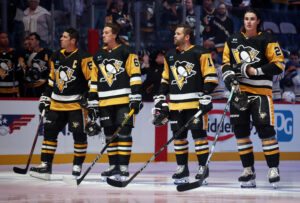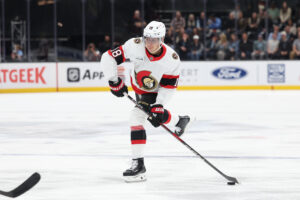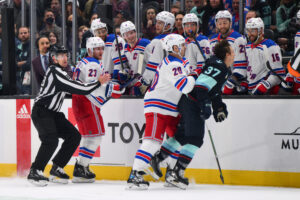The 2019-20 Vancouver Canucks captain has yet to be named, with less than a week to go until the season. The position has been vacant since Henrik Sedin‘s retirement at the end of 2017-18, though four alternate captains were named.
The presumptive nominee for years has been Bo Horvat. “Leadership” and “future captain” were regular refrains even before he was drafted, and nothing’s changed since. He was one of three players to gain an “A” last season, along with Alexander Edler and Brandon Sutter. They joined Chris Tanev, the only constant from the Sedin Era.
The History Surrounding the Pending Vancouver Canucks Captain
What Captains Do
But does having a single captain matter? What difference does it make if a team doesn’t have one, but several alternates instead?
Officially, no. The only purpose of a captain in the NHL is to act as the go-between for referees and the team. If there’s an on-ice conflict or disagreement with a call, the team captain will interact with the referee. Or, if they’re not on the ice at the time, an alternate captain. (That’s right, the “A” stands for alternate, not assistant or associate.) The captain also typically serves various off-ice responsibilities, as assigned by their teams. This can similarly be done by alternate captains, though. Captains need to be named before a game starts, but otherwise, there are no official limits on who it is. The Minnesota Wild had rotating captains for their first nine years until 2009-10. For two years, the Boston Bruins had two captains: Rick Middleton for home games and Ray Bourque on the road. They switched halfway through each season.
Rule 6 states that there can only be one captain and two alternate captains named for a game. It’s a rule that isn’t all that rigidly enforced, as the many variations around the league show. Last year, for instance, the Canucks had four alternate captains and no one wearing a “C” with no reprimand. Theoretically, more captains (or alternates) than just three would be necessary so one was on the ice at all times. Practically, though, refs and linesmen simply go to the bench if there isn’t one on the ice.
What Captains Really Do
Teams will place different responsibilities on their captains, depending on their histories, composition, expectations, etc. On most teams, captains are also the de facto leaders for players dealing with coaches or in between-player conflicts. They are expected to be available for post-game scrums, interviews, or outside media events. Captains have also coordinated team outings, both at home and on the road; led special events; and are generally the headliners for fan interactions.
In other words, they will quickly become the face of the team if they aren’t already.
Who To Use
Veterans are given the captaincy because they have been through the scrums, team fights, coaches, and so forth. They’ve been there, done that, and have a letter on their jersey to prove it. While it’s usually a high-skill player, that isn’t always necessary. A team could hold a vote, or it could be the head coach’s decision, or the GM could single someone out – though that last is thankfully rare. That veteran might be adept at defusing situations, a good communicator, or someone who lifts the spirits of the team. Or it might just be their reputation and nothing else (see below).
When a much younger player is named, they are invariably projected as a long-term member of the team. This is almost exclusively the domain of top draft picks like Connor McDavid or Sidney Crosby. If teams are going to name a rookie or sophomore captain, they need to be sure that the player sticks. To put a cynical spin on it, that adds pressure on a young, talented player to stay with the team.
Naming the most offensively skilled player on the team captain is an acknowledgement of their skills. Also, it kills two birds with one stone as that player is going to be a media favourite anyway. Since they are already facing the scrums, why subject another player to it?
The Vancouver Canucks Captains List
The Canucks have had all types of captains over their 49 years. Here’s the thirteen that have held the position to date:
Early On
Orland Kurtenbach, 1970-71 to 1973-74
In what can now be described as “a William Karlsson-esque Opportunity” the defensive specialist went from 14 points in 53 games in the 1969-70 season with the Rangers, to 53 points in 52 games as the first Vancouver Canucks captain the following year. He recorded the Canucks first – and his only – hat trick on December 12, 1970. The first player named to the team’s “Ring of Honour”. When he left the team, they decided to go without a captain the following year.
Andre Boudrias, 1975-76
Boudrias’ calling card was his single-season assist record, something he set in the 1974-75 season with 62 assists. This stood as the team’s record for 32 years before Henrik Sedin topped it with 71 in the 2006-07 campaign. Boudrias spent one season as the Canucks captain before leaving the team, and the league, for the Quebec Nordiques of the WHA for the final two years of his career. It was his famous forechecking and drive that earned Boudrias the captaincy. This trend of assigning the captaincy to high-work-ethic individuals become common with the team in years to come.
Chris Oddleifson, 1976-77
Only captain for one year, Oddleifson was a hard-nosed, versatile fan-favourite. An integral part of the team in the two years prior, his points also declined when he was named captain. His attention shifted to defensive play as better players came in.
Don Lever, 1977-78 to 1978-79
Lever was the first Vancouver Canucks captain to be drafted by the team, going third overall in the 1972 NHL Draft. He was a smart player, working effectively on both special teams. He ended up being more famous as the first captain – and first goal scorer – of the New Jersey Devils.
Kevin McCarthy, 1979-80 to 1981-82
The white-collars decided that Lever was enough of home-grown talent leading the team. They named defenceman McCarthy captain after he played one game for them, followed by hip surgery, in 1978-79. He recovered well enough to become a sensation, scoring 40+ points in his first four years with the team. He lost his captaincy during the 1982 playoffs. More specifically, he was injured during that miracle run and watched his replacement take over.
The Steamer Years
Stan Smyl, 1982-83 to 1989-90
A 5’8″ pressure cooker, Smyl made a name for himself early on in his career. In his first three games in the WCHL, Canadian’s top major-junior league at the time, Smyl tallied an impressive 15 penalty minutes. Nicknamed “Steamer”, he was a major part of making the New Westminster Bruins the first team to win consecutive Memorial Cups. He became captain of the Canucks when McCarthy broke his ankle just before the playoffs, and Smyl led the team to their first Stanley Cup Final. He kept the title for eight years before diminishing skills and reduced ice time led him to resign. His #12 was the first number to be retired by the team.
Dan Quinn, Doug Lidster, Trevor Linden, 1990-91
The Canucks named three co-captains for one season: Quinn, who arrived in a trade he previous year and would be traded away before the year ended; the Kamloops-born Lidster, a Canucks pick from 1980 and the team’s single-season points record holder for defencemen; and 1988 second-overall pick Linden. Given the choice to replace Smyl, Vancouver went with literally every “type” of captain. Quinn was an offensively skilled point-per-game guy on arrival. Lidster was a seven-year veteran with the respect of the team. And Linden was the young guy they wanted to keep in the fold.
Captain Canuck
Trevor Linden, 1990-91 to 1996-97
Like Smyl, Linden helped his Major Junior team win consecutive Memorial Cups before joining the Canucks in 1989. Linden spent 16 of his 20-year career in Vancouver and is legendary there. For single moments, he is probably most famous for fighting through cracked ribs from a cheap shot by Mark Messier to score two goals in Game Seven of the 1994 Stanley Cup Final. On the ice, his reputation is built from the hard work he put in every shift. He also had remarkable durability, at one point he playing in over 480 consecutive games.
Off the ice, his charity work and community involvement earned him the Order of BC and the Order of Canada. Immensely respected by other players, he was voted head of the NHLPA for eight years. Traded away by GM Mike Keenan in February of 1998, he was brought back in November of 2001. He played another six years as an alternate captain, finally retiring in 2008. His was the second jersey retired by the Canucks.
Who?
Mark Messier, 1997-98 to 1999-2000
Messier holds a legacy as one of the most hated players to suit up in a Vancouver Canucks jersey and awarding him the captaincy was arguably one of the most tone-deaf moves made by a professional sports team. He spent three years with the team and, after he left in free agency, ticket sales rose by almost 2500 seats-per-game, showing the true spite fans had for Messier.
Back to Normal
Markus Naslund, 2000-01 to 2007-08
Traded to Vancouver in one of the most lopsided deals in NHL history, Naslund had a shaky start with the Canucks. He scored zero points in his first nine games, then in the final game of the year got a hat trick to qualify the team for the playoffs. A very quiet leader, he was likely originally given the role because of his excellent offensive skills. He grew into the duty of Vancouver Canucks captain, though, becoming more comfortable with it as his career progressed. He held loads of records for the team until the Sedins’ arrival.
Roberto Luongo, 2008-09 to 2009-10
Did we say “back to normal” up there? That changed when Luongo was named captain for the 2008-09 season. It was the first time a goalie had been named captain in sixty years and wasn’t ‘officially’ allowed (Rule 6.1). Because of that, on the ice, the team had four alternate captains (naming three for each game). In the dressing room and for public events, however, Luongo was the captain.
The move wasn’t well-received by fans, and he was under greater scrutiny after two years of playoff losses. It was eventually decided that the letter was too distracting, and he gave up captaincy after just two seasons.
Henrik Sedin, 2010-11 to 2017-18
“Hank” wore an “A” in Luongo’s second year as captain, taking over for him that off-season. Another “Quiet Leader” type, he had been with the team for ten years and become an offensive powerhouse. The year before being named captain, he scored a team-record 83 assists and 112 points. In his first year as captain, the Canucks made their third Stanley Cup Final run. He was the first Canuck to win the Art Ross Trophy, and also the first to win the Hart Trophy. Off the ice, he continued the captain’s tradition of charitable work, winning two King Clancy Memorial Trophies in recognition.
Lucky Number 14
There are arguments to be made for different players being named Vancouver Canucks Captain this year. Brock Boeser has kept an even keel through tremendous personal hardship, remaining productive on the ice despite the pressure. Alexander Edler has been a top player on the Canucks for a decade, playing through the best and worst times. Chris Tanev is the longest-tenured alternate captain on the team. Elias Pettersson is clearly heading for stardom, possibly challenging for the title of being the best player in Canuck history.
But in reality, the question has a foregone conclusion. When it comes to facing media scrums, carrying a team as their best all-around player, and being a fan favourite, the team should listen to two of their stars:
https://youtu.be/0Dgjp3yEyOE?t=139
Main Photo:






